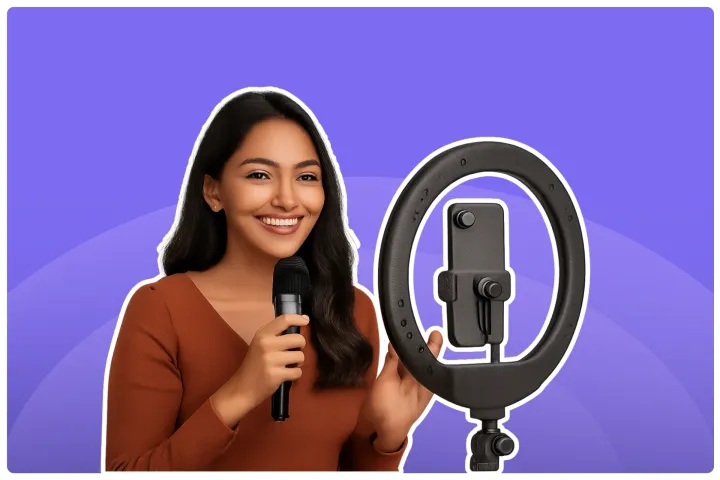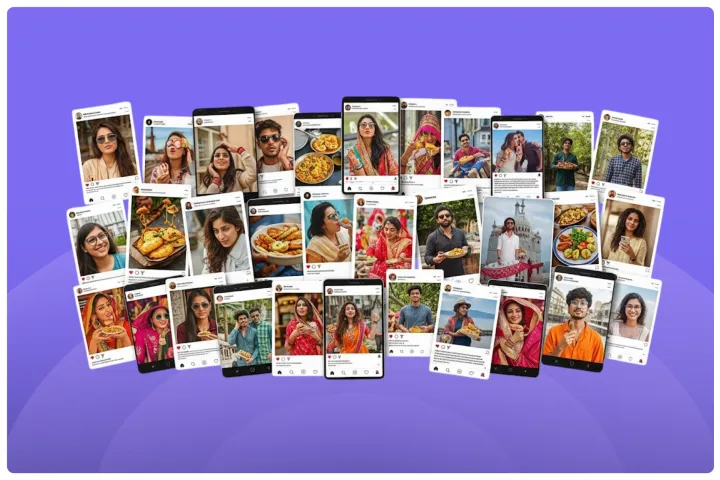User Generated Content Vs Professional Content (2025)
Confused about user-generated content vs. professional content? Get the complete scoop on their differences and how to leverage them for success!
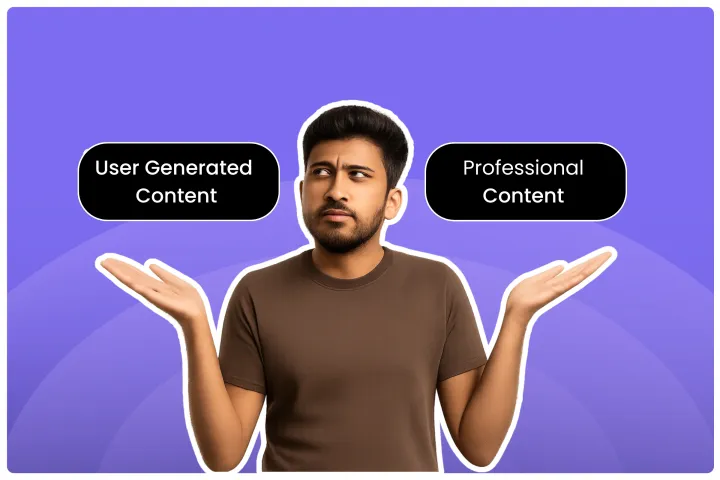
You're probably wondering how to best connect with your audience, build trust, and ultimately grow your business in today's busy digital space. Two powerful tools keep popping up: User-Generated Content (UGC) and Professional Influencer Content.
But what's the difference? When should you use which? And how can you make them work together like a dream team? 🤔 Don't worry, we've got you covered!
Think of this article as your friendly guide. We'll break down everything you need to know about UGC and professional influencer content, compare them side-by-side, and show you how to strategically use both to achieve your marketing goals. We'll even sprinkle in some real-world examples and insights specific to the vibrant Indian market. Ready to get started? Let's go! ✨
User Generated Content Vs Professional Content
First things first, let's understand these two content types. They might sound similar, but they come from different places and serve distinct purposes.
What is User-Generated Content (UGC)?
Picture this: a customer absolutely loves your new product. They snap a photo, share it on Instagram, and tag your brand, telling all their friends how great it is. That, my friend, is User-Generated Content (UGC) in its purest form.
Definition: UGC is any form of content—text, images, videos, reviews, audio—created by everyday people (consumers, users, fans) about your brand, product, or service. The key here is that it's typically created organically and voluntarily, without direct payment or heavy brand control. It’s the digital version of word-of-mouth, powered by genuine enthusiasm.
Characteristics:

1) Authentic and relatable: This is UGC's superpower! 💪 Because it comes from real people, not the brand itself, audiences perceive it as more genuine, trustworthy, and relatable. Think about it – who do you trust more when deciding on a restaurant? The fancy ad or your friend's enthusiastic recommendation?
Research consistently shows this preference. Studies reveal that a staggering 92% of consumers trust peer recommendations (like UGC) more than traditional advertising. Another report found that 60% of people believe UGC is the most authentic form of content, leagues ahead of brand-created content (around 20%). It feels like advice from a friend, not a sales pitch.
2) Often shared voluntarily on social media platforms: People share UGC for various reasons: they love the product, they had a great experience, they want to be part of a community, they want to share their creativity, or maybe they're participating in a contest. It springs from genuine user experiences and motivations. Platforms like Instagram, Facebook, TikTok, YouTube, and review sites (like Google Reviews, Zomato, e-commerce product pages) are hotspots for UGC.
3) Includes reviews, testimonials, photos, and videos: UGC comes in many flavours!
- Reviews: Star ratings and written feedback on e-commerce sites, Google Maps, Zomato, Swiggy, etc. These are crucial for purchase decisions – data shows around 70% of shoppers check reviews before buying!
- Testimonials: Customers sharing positive experiences, often in short video clips or quotes used on websites.
- Photos: Customers showcasing your product in their daily lives – wearing your clothes, using your gadget, visiting your cafe. Think Instagram posts with your brand tagged or using your unique hashtag.
- Videos: Unboxing videos, how-to tutorials using your product, TikTok challenges featuring your brand, travel vlogs visiting your location. Video UGC is incredibly engaging!
Examples:
Customer reviews on e-commerce sites: Think about Browse Flipkart or Amazon. Those star ratings and detailed comments from other buyers? That's prime UGC influencing your decision. Imagine seeing a review like, "This kurta from [Your Brand] is even prettier in person! Perfect fit and great quality. Got so many compliments at the Diwali party! ✨" – that's gold!
Unboxing videos on YouTube: A beauty enthusiast excitedly opens your latest makeup kit, swatching colours and sharing first impressions. Or a tech fan unboxes your new headphones, discussing the packaging, features, and sound quality. These videos offer an authentic first look that viewers trust. Picture someone saying, "Wow, the packaging from [Your Brand] feels so premium! Let's see what's inside..."
UGC is like having an army of brand cheerleaders... who genuinely love and use your stuff! It’s raw, real, and incredibly powerful for building trust.
What is Professional Influencer Content?
Now, let's shift gears to the pros. Professional Influencer Content, sometimes called Influencer-Generated Content (IGC), is different.
Definition: This is content created by individuals who have built a dedicated online following and influence within a specific niche (like fashion, tech, food, travel, finance, etc.). Crucially, this content is usually created as part of a paid collaboration or sponsorship agreement between the influencer and the brand.
Influencers are professional creators. They understand content creation, audience engagement, and how to partner with brands effectively. They leverage their credibility and reach to promote products or services to their followers.
Characteristics:

1) Strategic partnerships and sponsorships: This isn't usually spontaneous. Brands actively seek out influencers whose audience matches their target market. Collaborations are planned, often involving contracts, creative briefs, and specific deliverables (e.g., 2 Instagram posts, 1 Reel, 3 Stories). Payment can be monetary (fees ranging from a few thousand rupees for nano-influencers to many lakhs for celebrities), free products (barter), or a combination. Recent data suggests the Indian influencer marketing market is booming, projected to exceed ₹3,000 crores!
2) High-quality, polished content: Influencers are typically skilled creators. They often have better equipment (cameras, lighting, mics), editing software, and a keen eye for aesthetics. The content produced is usually high-resolution, well-edited, and visually appealing, aligning with the brand's desired image. While authenticity is still key, the presentation is generally more professional than typical UGC.
3) Tailored messaging aligned with brand objectives: Because it's a paid partnership, brands have more control over the message. They provide influencers with key talking points, campaign goals, specific hashtags to use, and calls-to-action (e.g., "Swipe up to shop," "Use my code BRAND15 for a discount").
The influencer then crafts the content in their own style to resonate with their audience, incorporating the brand's requirements. Mandatory disclosure like #ad, #sponsored, or #partnership is essential for transparency.
Examples:
Sponsored posts on Instagram: A popular fashion influencer posts a carousel of high-quality images wearing your brand's latest collection, describing the fabric and fit, and including a direct link to purchase in their bio or story. The caption clearly states it's a paid partnership. Imagine a post: A travel influencer shares breathtaking photos from a stay at your hotel, highlighting the amenities and views, with "#ad
@[YourHotelBrand]" clearly visible.
Product reviews by YouTubers: A well-known tech reviewer creates a detailed 15-minute video reviewing your new smartphone. They cover specs, performance, camera quality, pros, and cons, demonstrating the product in action. While sponsored, reputable reviewers maintain objectivity to keep their audience's trust. This gives potential customers an in-depth look from a trusted source.
Professional influencer content leverages the creator's reach and credibility to put your brand in front of a relevant, engaged audience, often with a high degree of polish and controlled messaging.
Comparative Analysis
Okay, let's put UGC and Professional Influencer Content head-to-head on key aspects relevant to you, the brand:
The Bottom Line:
- Choose UGC when your priority is building deep trust, fostering community, showcasing authentic social proof, and working with a limited budget.
- Choose Professional Influencer Content when your priority is achieving broad reach quickly, launching new products with buzz, maintaining high creative control, and targeting specific demographics predictably.
But wait... does it have to be either/or? 🤔 Not at all! The real magic often lies in combining them.
Strategic Applications: User Generated Content Vs Professional Content
Understanding the what and the comparison is great, but how do you actually use these content types strategically for your brand? Let's explore the best scenarios for each.
When to Leverage UGC?
Tap into the power of your actual customers! UGC is fantastic for:

1) Building Brand Trust and Advocacy:
Nothing screams "people love us!" louder than genuine customer content. When potential buyers see real people enjoying your products or services, it acts as powerful social proof. Remember, 84% of millennials trust brands more when they incorporate UGC.
How to use it: Feature customer photos on your product pages. Embed positive Google reviews on your website. Create testimonial videos using snippets from happy customers (always ask permission!). Run campaigns encouraging users to share how they use your product with a unique hashtag (e.g., #My[YourBrand]Style).
Example: Imagine you sell eco-friendly home goods. Feature Instagram photos from customers showing your bamboo toothbrush or reusable containers in their homes. This visually reinforces your brand values and builds trust with like-minded consumers.
2) Running Cost-Effective Campaigns:
Are you a startup or a small business watching every rupee? UGC is your best friend! Generating content can be expensive, but your customers can become your content creators, often for free or minimal cost.
As mentioned, 85% of marketers see visual UGC as more cost-effective than professional photography or influencer content.
How to use it: Launch a photo or video contest asking users to share their best experience with your brand. Offer a modest prize (like a product hamper worth ₹5,000 or a gift voucher). Use a clear hashtag to collect entries. You get a wealth of content and engagement for a fraction of the cost of a traditional campaign.
Story Time! Let's talk about Riya. She runs a small online bakery in Pune. With a tiny marketing budget,
she started a simple contest: "Share a photo enjoying our cake using #RiyasSweetTreats. Best photo wins a free cake!" The response was amazing! 🎂 She got dozens of mouth-watering photos, saw a jump in followers, and had authentic content to share for weeks – all for the cost of one cake!
3) Fostering Community and Loyalty:
UGC isn't just about getting content; it's about building relationships. When you acknowledge and share customer content, you make them feel seen, valued, and part of a community. This strengthens loyalty and encourages repeat business.
How to use it: Regularly repost customer photos and stories on your social media (tagging the creator!). Create a dedicated "Community" highlight reel on Instagram. Respond to reviews (even negative ones, constructively!). Make your customers feel like insiders. Use emojis like 🙏💖🤝 to show appreciation.
Think: Brands like GoPro built empires on UGC. They encourage users to share incredible adventure footage shot on their cameras, creating a passionate global community.
Leverage UGC when authenticity, trust, community, and budget-friendliness are your top priorities.
When to Utilize Professional Influencer Content
Sometimes, you need that extra reach, polish, or targeted approach. That's where influencers shine:
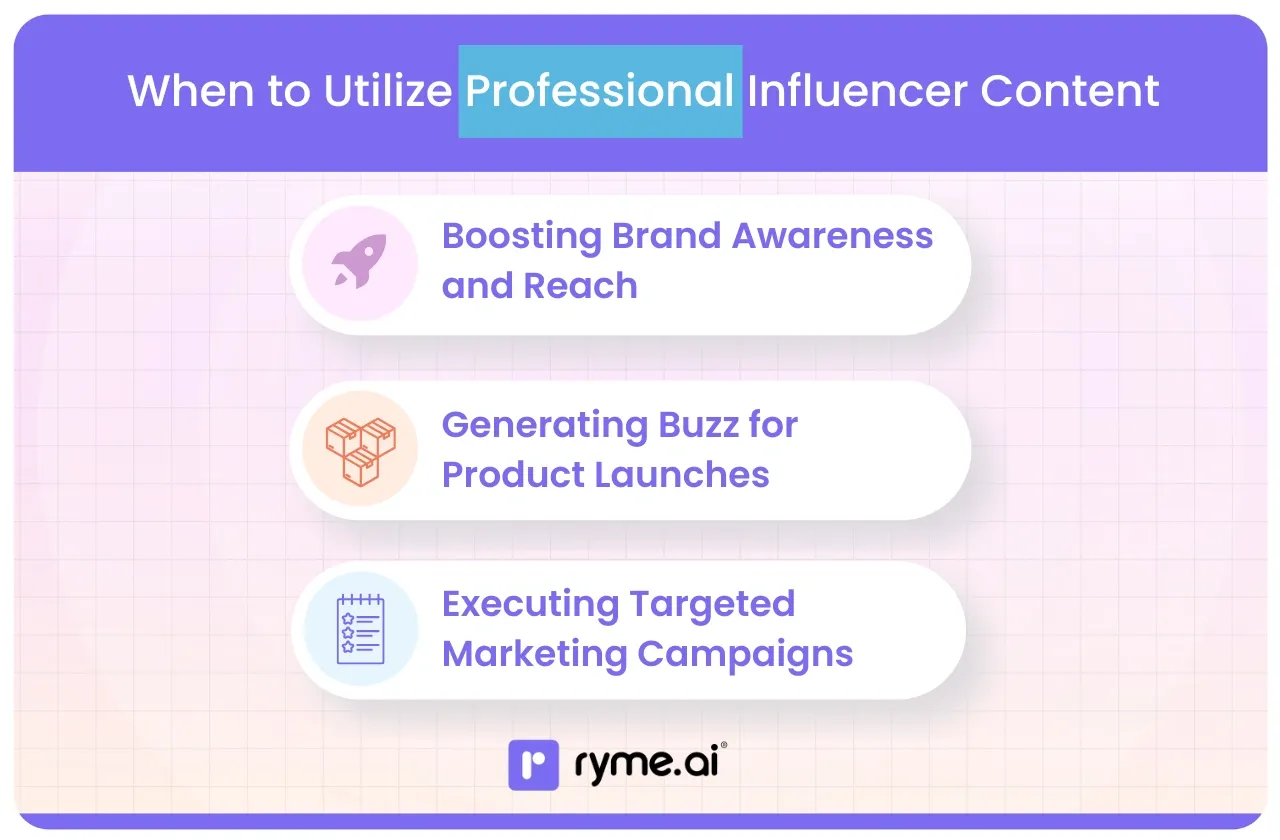
1) Boosting Brand Awareness and Reach:
Want to get your brand name out there, fast? Influencers offer a direct line to potentially massive audiences. Collaborating with macro-influencers or even celebrities can expose your brand to hundreds of thousands, or millions, of potential customers almost instantly. This is great for new brand launches or entering new markets. Remember, influencers drive about 20% more purchases than traditional ads, and 72% of Indian consumers trust their recommendations.
How to use it: Partner with influencers for sponsored posts, Reels, or YouTube videos showcasing your brand. Run awareness campaigns focused on reach and impressions. Choose influencers whose audience demographics align with your target customer.
Example: A new D2C snack brand wants to make noise quickly. They partner with a few popular food bloggers and lifestyle influencers across India for coordinated Instagram posts and Reels during launch week, instantly putting their product in front of foodie audiences nationwide. Costs might range from ₹50,000 to ₹5,00,000+ depending on the influencers chosen.
2) Generating Buzz for Product Launches:
Launching something new and exciting? 🚀 Influencers are masters at creating anticipation and buzz. They can produce high-quality teaser content, host live unboxing sessions, offer exclusive launch-day discounts with unique codes, and provide compelling first-look reviews.
How to use it: Send your new product to relevant influencers before the official launch for unboxing videos and initial reviews. Coordinate a "launch day blast" where multiple influencers post about the product simultaneously. Have an influencer host an Instagram Live Q&A session about the new product.
Story Time! When "TechGuru India" (a hypothetical large tech company) launched their latest smartphone, they collaborated with 10 top tech YouTubers and 20 micro-influencers on Instagram. The YouTubers released detailed reviews on launch day, while the Instagrammers created slick Reels showcasing the phone's camera features. Result? Massive online conversation, trending hashtags, and a surge in pre-orders. The investment? Likely several crores, but the impact was significant.
3) Executing Targeted Marketing Campaigns:
Need to reach a very specific audience? Niche influencers are your secret weapon! Whether you're targeting vegan food lovers in Bangalore, sustainable fashion enthusiasts in Mumbai, or coding students across Tier-2 cities, there's likely an influencer connecting with that exact group.
Micro-influencers (10k-100k followers) and nano-influencers (<10k followers) often have highly engaged, dedicated communities within specific niches. Collaborating with them ensures your message reaches the right ears (and eyes!). The rise of regional language influencers in India further allows for hyper-targeting.
How to use it: Identify influencers in your specific niche using platforms or manual research. Collaborate on content that speaks directly to their audience's interests. Use niche influencers for promoting specialized products or services where broad appeal isn't the goal, but deep relevance is. A campaign with 5 relevant micro-influencers might cost ₹50,000 - ₹2,50,000 and yield better results for a niche product than one macro-influencer campaign.
Utilize professional influencer content when speed, broad reach, high production value, controlled messaging, or hyper-targeted niche marketing are essential.
Integrating UGC and Influencer Content
Okay, we've seen the strengths of both. Now, let's talk about the ultimate power move: using them together. 💪 Why choose when you can have the best of both worlds?
Integrating UGC and influencer content allows you to combine the raw authenticity and trust of customer voices with the polished reach and credibility of professional creators. It's a synergistic approach that can amplify your message and impact. Think of it like a delicious fusion dish – combining distinct flavours to create something even better! 😋
Research supports this! ComScore found that brand engagement jumps by a significant 28% when consumers are exposed to a mix of professional brand content and UGC. It creates a more rounded, believable, and engaging brand presence.
Complementary Strategies: Making 1 + 1 = 3
How can you blend these two content types effectively?
- Amplify UGC with Influencers: Found an amazing piece of UGC – a stunning photo or a heartfelt video testimonial? Partner with an influencer to share or react to that UGC, giving it a massive reach boost while validating the customer's positive experience.
- Use Influencers to Drive UGC Creation: Run a campaign where influencers kickstart a challenge or contest, asking their followers to participate by creating and sharing their own UGC using your brand hashtag. The influencer provides the initial push and credibility, motivating their audience to join in.
- Social Proof Layering: Feature authentic UGC (reviews, photos) prominently on your product pages or website. Then, run targeted influencer campaigns driving traffic to those pages. Visitors arriving via an influencer link are immediately greeted with real customer validation, increasing conversion likelihood.
- Content Repurposing: Take high-quality content created by an influencer (with permission and rights cleared, of course!) and incorporate it into your broader marketing – perhaps using snippets in social ads, email newsletters, or website banners. Conversely, weave authentic UGC into influencer briefs as inspiration or proof points.
Example Scenario:
Imagine you're a travel company promoting tours to Kerala.
- UGC Foundation: You encourage travellers to share photos using #KeralaAdventuresWith[YourBrand]. You curate the best shots (get permission!) and feature them in a gallery on your website and in social posts, showcasing real traveller experiences. You highlight glowing customer reviews.
- Influencer Boost: You collaborate with a popular Indian travel influencer (let's say they charge ₹3,00,000 for a package). They go on one of your tours and create stunning Reels and blog posts about their experience, using the same hashtag #KeralaAdventuresWith[YourBrand].
- Integration: The influencer's content drives traffic to your website, where visitors see the authentic UGC gallery and reviews, reinforcing the positive message. The influencer also encourages their followers to share their own Kerala memories using the hashtag, further fueling UGC creation. You then use some of the best UGC photos in retargeting ads shown to people who engaged with the influencer's content.
See how they work together? Authenticity meets reach, trust meets polish. ✨
Best Practices for Integration:
Managing both UGC and influencer content requires a thoughtful approach. Here are some key practices:
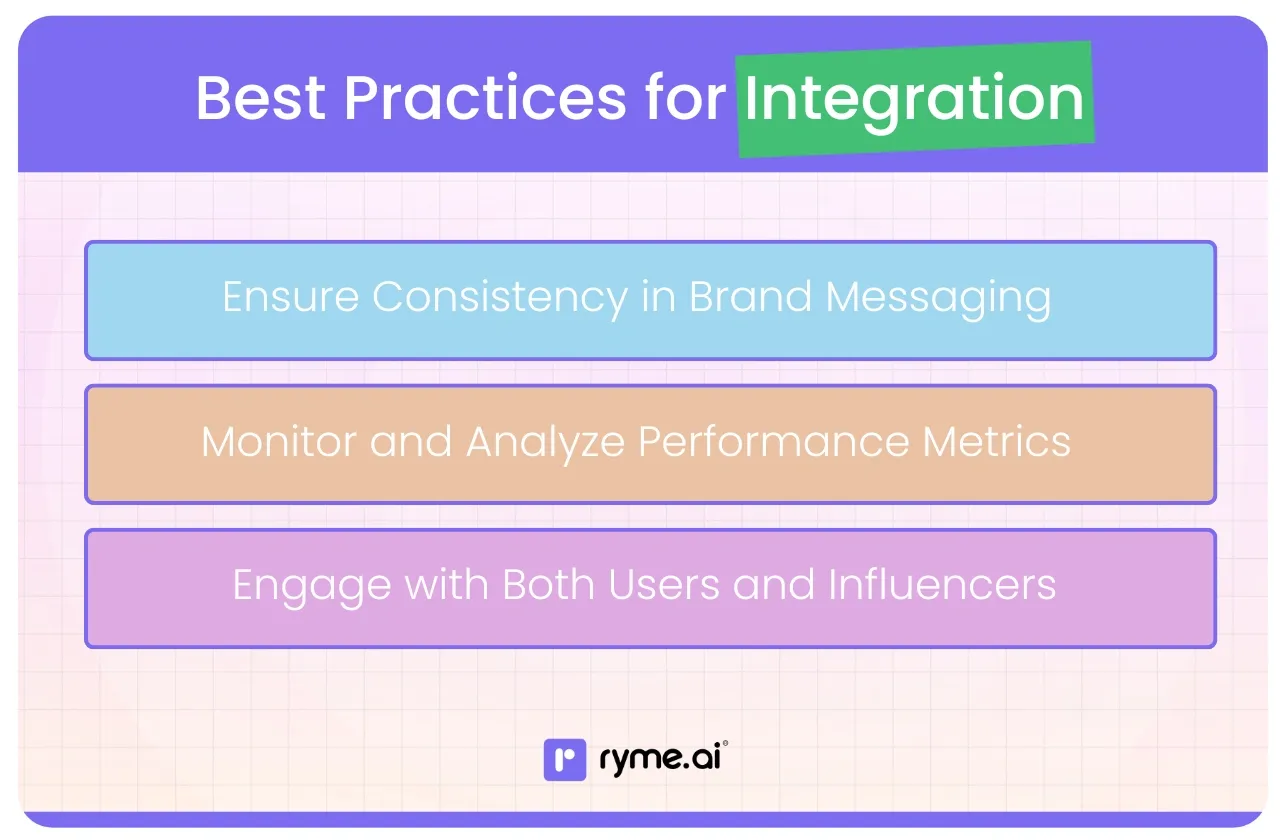
1) Ensure Consistency in Brand Messaging:
Your core brand values, tone of voice, and key messages should feel consistent, whether they appear in a customer's candid photo or an influencer's polished Reel. Provide clear brand guidelines to influencers and ensure the UGC you choose to highlight aligns with your overall brand identity. Avoid jarring contrasts that might confuse your audience.
2) Monitor and Analyze Performance Metrics:
Don't just create content – measure its impact! Track key performance indicators (KPIs) for both UGC initiatives and influencer campaigns. Look at engagement rates (likes, comments, shares), reach, website traffic, conversion rates (sales, sign-ups), sentiment analysis, and ultimately, Return on Investment (ROI).
Use platform analytics, UTM tracking codes, and specific promo codes to attribute results. Recent stats show 83% of brands now measure influencer marketing ROI. Understanding what works allows you to refine your strategy and allocate your budget wisely (whether it's ₹10,000 or ₹10,00,000!).
3) Engage with Both Users and Influencers:
Content creation shouldn't be a one-way street. Actively engage with users who create UGC – thank them, respond to comments, make them feel appreciated 🙏. Build genuine relationships with influencers beyond just transactional campaigns – understand their audience, trust their creative input (within guidelines), and foster long-term partnerships where possible. This builds a stronger, more authentic ecosystem around your brand.
Integrating UGC and influencer marketing isn't just about posting different types of content; it's about weaving them together into a cohesive, compelling brand story that resonates deeply with your audience.
Best UGC and Influencer Marketing Platform in India
Okay, managing UGC sourcing, getting permissions, finding the right influencers, negotiating rates, handling contracts, tracking campaigns, and measuring ROI... it sounds like a lot, right? 😅 Especially if you're a busy brand owner or marketing manager in India.
This is where technology can be a massive help! Platforms are emerging to streamline this whole process, making it easier and more effective to leverage both UGC and influencer power. One such platform designed with the Indian market in mind is ryme.ai.
Think of ryme.ai as your command center for creator collaborations. It's a UGC & Influencer Collaboration platform built to simplify how brands connect with creators (both everyday users and professional influencers) and manage campaigns efficiently.
Key Features (and what they mean for YOU):
1) AI-Powered Influencer Matching:
Stop spending hours scrolling Instagram! ryme.ai uses artificial intelligence to analyze influencer profiles, content, and audience demographics. It matches your brand with influencers whose followers genuinely align with your target customer base.
Benefit for you: Saves massive amounts of time, reduces guesswork, increases the likelihood of campaign success because you're reaching the right people. Better targeting = Better ROI. ✅
2) Zero-Commission Model:
Traditional influencer agencies often charge hefty commissions (sometimes 15-30%) on top of influencer fees. ryme.ai operates on a different model, aiming to eliminate these extra platform or agency fees.
Benefit for you: Makes influencer marketing significantly more affordable and accessible, especially for startups and SMBs. Your budget (whether it's ₹20,000 or ₹2,00,000) goes directly towards the creators and campaign, not middlemen. More bang for your buck! 💰
3) Real-Time Analytics:
Data is power! The platform provides deep insights into your campaign performance, often using direct API data (like from Meta for Instagram/Facebook campaigns) for accuracy. Track reach, engagement, clicks, conversions, and ROI in near real-time.
Benefit for you: Make informed, data-driven decisions. Understand what's working and what's not. Easily generate reports to showcase campaign success and justify marketing spend. Optimize campaigns on the fly. 📊
4) Streamlined Content Workflows:
From initial outreach and negotiation to content approvals and payments, managing collaborations can be complex. ryme.ai aims to simplify this entire process within the platform.
Benefit for you: Less administrative hassle, smoother communication, faster campaign execution. Saves valuable time and reduces potential errors or miscommunications. More efficient collaboration = happier brands and happier creators. 👍
Using ryme.ai can take the complexity out of integrating UGC and influencer marketing, allowing you to focus on strategy and results while leveraging technology to handle the heavy lifting.
Conclusion
Whew! We've covered a lot of ground, haven't we? From the raw authenticity of User-Generated Content (UGC) to the polished reach of Professional Influencer Content, you now have a clearer picture of these powerful marketing tools.
Let's quickly recap the essence:
- UGC (User-Generated Content): Your customers' voice. It's authentic, trustworthy, cost-effective, and brilliant for building community and social proof. Think real reviews, customer photos, and unboxing videos.
- Professional Influencer Content: Content from paid creators. It offers extensive reach, high production quality, controlled messaging, and targeted audience access. Think sponsored Instagram posts and detailed YouTube reviews.
While each has its unique strengths and ideal use cases, the smartest strategy often involves integration.
Combining the trust-building power of UGC with the awareness-driving potential of influencers can create a marketing synergy that truly resonates with modern consumers, especially here in India's dynamic digital market.
The most important thing is to be authentic, provide value, and build genuine connections. Your audience – whether they're customers sharing UGC or followers engaging with an influencer – is waiting to connect with your brand story. Now go out there and make it happen! ✨🚀
UGC & Professional Content Related FAQs
Got a few more questions? We anticipated that! Here are answers to some common queries:
1) What are the main differences between user-generated content vs professionally made content?
Think of it like this:
- Creator: UGC is made by regular users/customers, often unpaid. Professional content is made by paid individuals (influencers, agencies, photographers, videographers) hired by the brand.
- Motivation: UGC stems from genuine experience, love for the brand, or desire to share/participate. Professional content is created as part of a paid agreement or contract.
- Cost: UGC is typically free or low-cost for the brand (maybe contest prizes). Professional content involves fees for services (can range from thousands to lakhs of rupees).
- Control: Brands have limited control over organic UGC (they can curate but not dictate). Brands have high control over professional content via briefs and approvals.
- Authenticity: UGC is generally perceived as highly authentic ("real people"). Professional content's authenticity can be seen as moderate due to its paid nature, though good influencers maintain trust.
- Quality: UGC quality varies (can be raw, unpolished). Professional content is usually high-quality, polished, and technically proficient.
2) What is professional-generated content?
Professional-generated content is any content created for a brand by individuals or entities who are paid for their creative services. This umbrella term includes content made by:
- Influencers (IGC - Influencer Generated Content): As discussed, content created by social media influencers in collaboration with a brand.
- Marketing Agencies: Ad copy, graphics, videos produced by your advertising or marketing agency.
- Professional Photographers/Videographers: High-quality product shots, brand videos, commercials commissioned by the brand.
- In-house Creative Teams: Content created by the brand's own designers, writers, and marketers.
Essentially, if the brand commissioned and paid for the content's creation according to specific guidelines, it's professional-generated content.
3) What is the difference between CGC and UGC?
CGC stands for Customer-Generated Content, while UGC stands for User-Generated Content. Often, these terms are used interchangeably. However, there can be a subtle distinction:
- UGC (User-Generated Content): This is the broader term. It refers to any content created by any user (not necessarily a paying customer) that mentions or features the brand. It could be someone simply commenting on a post, using a branded filter, or creating fan art.
- CGC (Customer-Generated Content): This is often considered a subset of UGC. It specifically refers to content created by actual paying customers relating directly to their experience with the product or service. Think product reviews, testimonials after purchase, photos of them using the product they bought.
- Why it matters (or doesn't): For most practical marketing purposes, the distinction isn't critical. Both rely on authenticity and external voices. Some definitions emphasize that CGC is more focused on direct feedback and product experience sharing. The key takeaway is that content generated by people outside the brand holds significant persuasive power.
4) What is the difference between UGC and IGC?
This is a clearer distinction:
- UGC (User-Generated Content): Content created organically and usually unpaid by everyday users or customers of a brand. Driven by personal experience or enthusiasm.
- IGC (Influencer-Generated Content): Content created by social media influencers as part of a paid partnership or collaboration with a brand. Driven by a contractual agreement and brand objectives, though executed in the influencer's style.
- Think of it as Earned vs. Paid creator content: UGC is earned media from your audience; IGC is paid media created by hired professionals (who happen to be influencers). IGC is a type of professional-generated content.
Your Actionable Content Checklist
Ready to put this knowledge into action? Here’s a quick checklist to get you started:
✅ Define Your Goals: What do you want to achieve? (e.g., Increase brand trust? Drive sales for a new product? Build a community?) Your goal will guide your content choices.
✅ Know Your Audience: Who are you trying to reach? Where do they spend time online? What kind of content do they trust and engage with?
✅ Encourage UGC: Make it easy for customers to share!
Create a unique, memorable brand hashtag (e.g., #[YourBrand]Moments).
- Ask for reviews post-purchase.
- Run simple photo/video contests or challenges.
- Prompt sharing on social media.
✅ Curate & Showcase UGC: Find the gems!
- Monitor your hashtag and brand mentions.
- Crucially: Always ask for permission before reposting or using UGC! 🙏
- Feature customer content on your social feeds, website (galleries, product pages), and even in ads (with rights cleared). Credit the creators!
✅ Research Relevant Influencers: If influencer marketing fits your goals:
- Look for creators in your niche whose audience matches yours.
- Consider starting with micro- or nano-influencers for targeted engagement and potentially lower costs (₹5,000 - ₹50,000 range).
- Check their engagement rates and audience authenticity.
✅ Develop Clear Influencer Briefs: Outline campaign goals, key messages, deliverables, timeline, usage rights, and payment terms. But allow for creative freedom!
✅ Integrate Strategically: Think about how UGC and influencer content can support each other (e.g., influencer contest drives UGC submissions).
✅ Track Your Results: Monitor engagement, reach, traffic, conversions, and ROI for both UGC initiatives and influencer campaigns. Use analytics!
✅ Consider a Platform: If managing multiple campaigns feels complex, explore platforms like ryme.ai to streamline workflows, discovery, and analytics. 😉
✅ Stay Authentic & Engage: Respond to comments, thank creators, build relationships. Be human! ❤️
